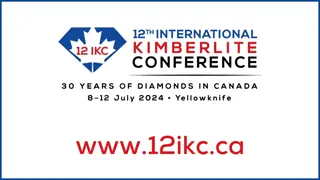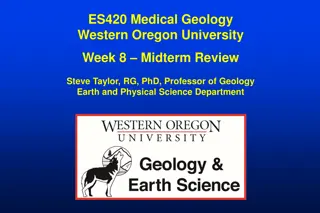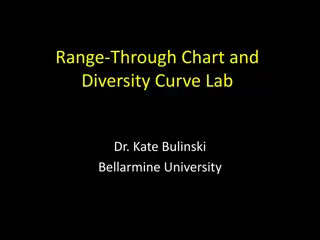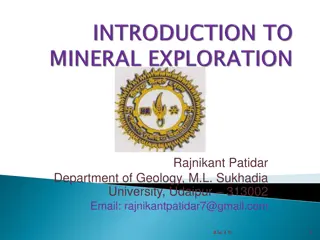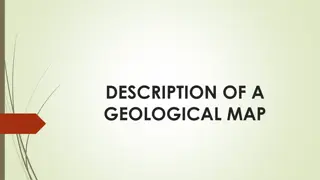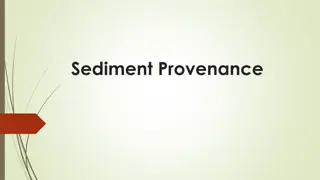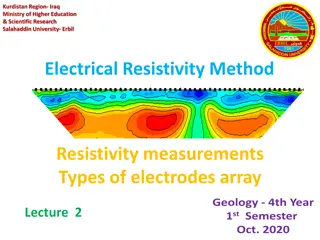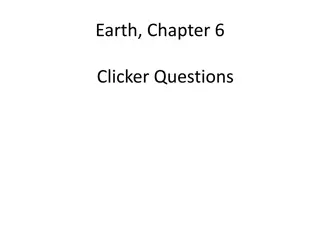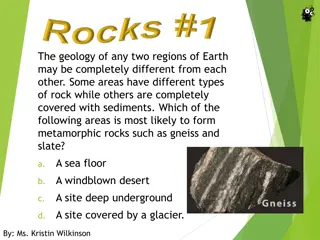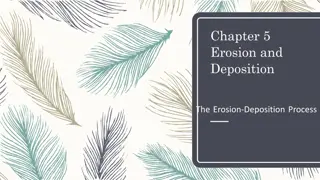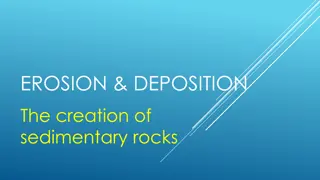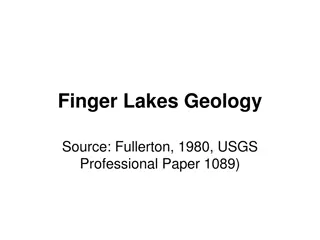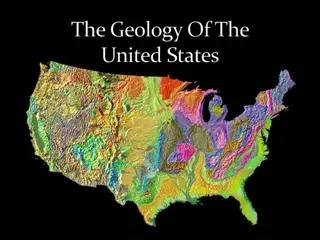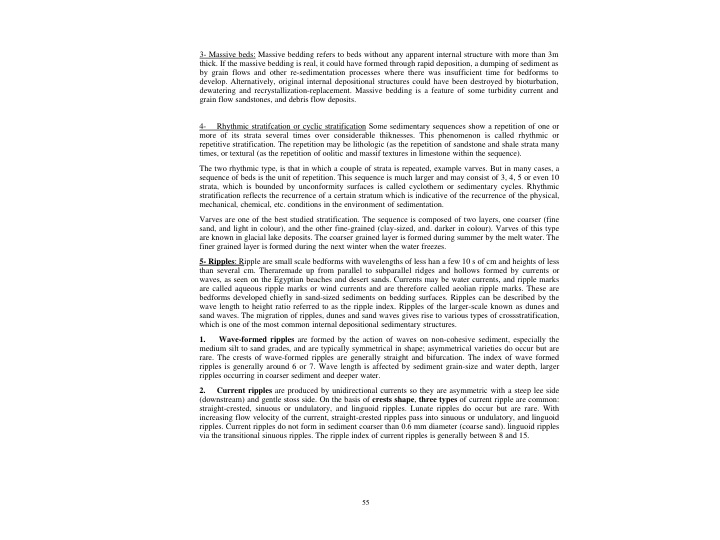
Sedimentary Structures: Massive Beds, Rhythmic Stratification, and Ripples
Discover the formation processes and characteristics of massive beds, rhythmic stratification, and ripples in sedimentary sequences. Learn about the different types of bedding and how they reflect environmental conditions and sedimentation processes.
Download Presentation

Please find below an Image/Link to download the presentation.
The content on the website is provided AS IS for your information and personal use only. It may not be sold, licensed, or shared on other websites without obtaining consent from the author. If you encounter any issues during the download, it is possible that the publisher has removed the file from their server.
You are allowed to download the files provided on this website for personal or commercial use, subject to the condition that they are used lawfully. All files are the property of their respective owners.
The content on the website is provided AS IS for your information and personal use only. It may not be sold, licensed, or shared on other websites without obtaining consent from the author.
E N D
Presentation Transcript
3- Massive beds: Massive bedding refers to beds without any apparent internal structure with more than 3m thick. If the massive bedding is real, it could have formed through rapid deposition, a dumping of sediment as by grain flows and other re-sedimentation processes where there was insufficient time for bedforms to develop. Alternatively, original internal depositional structures could have been destroyed by bioturbation, dewatering and recrystallization-replacement. Massive bedding is a feature of some turbidity current and grain flow sandstones, and debris flow deposits. 4- Rhythmic stratifcation or cyclic stratification Some sedimentary sequences show a repetition of one or more of its strata several times over considerable thiknesses. This phenomenon is called rhythmic or repetitive stratification. The repetition may be lithologic (as the repetition of sandstone and shale strata many times, or textural (as the repetition of oolitic and massif textures in limestone within the sequence). The two rhythmic type, is that in which a couple of strata is repeated, example varves. But in many cases, a sequence of beds is the unit of repetition. This sequence is much larger and may consist of 3, 4, 5 or even 10 strata, which is bounded by unconformity surfaces is called cyclothem or sedimentary cycles. Rhythmic stratification reflects the recurrence of a certain stratum which is indicative of the recurrence of the physical, mechanical, chemical, etc. conditions in the environment of sedimentation. Varves are one of the best studied stratification. The sequence is composed of two layers, one coarser (fine sand, and light in colour), and the other fine-grained (clay-sized, and. darker in colour). Varves of this type are known in glacial lake deposits. The coarser grained layer is formed during summer by the melt water. The finer grained layer is formed during the next winter when the water freezes. 5- Ripples: Ripple are small scale bedforms with wavelengths of less han a few 10 s of cm and heights of less than several cm. Theraremade up from parallel to subparallel ridges and hollows formed by currents or waves, as seen on the Egyptian beaches and desert sands. Currents may be water currents, and ripple marks are called aqueous ripple marks or wind currents and are therefore called aeolian ripple marks. These are bedforms developed chiefly in sand-sized sediments on bedding surfaces. Ripples can be described by the wave length to height ratio referred to as the ripple index. Ripples of the larger-scale known as dunes and sand waves. The migration of ripples, dunes and sand waves gives rise to various types of crossstratification, which is one of the most common internal depositional sedimentary structures. 1. Wave-formed ripples are formed by the action of waves on non-cohesive sediment, especially the medium silt to sand grades, and are typically symmetrical in shape; asymmetrical varieties do occur but are rare. The crests of wave-formed ripples are generally straight and bifurcation. The index of wave formed ripples is generally around 6 or 7. Wave length is affected by sediment grain-size and water depth, larger ripples occurring in coarser sediment and deeper water. 2. Current ripples are produced by unidirectional currents so they are asymmetric with a steep lee side (downstream) and gentle stoss side. On the basis of crests shape, three types of current ripple are common: straight-crested, sinuous or undulatory, and linguoid ripples. Lunate ripples do occur but are rare. With increasing flow velocity of the current, straight-crested ripples pass into sinuous or undulatory, and linguoid ripples. Current ripples do not form in sediment coarser than 0.6 mm diameter (coarse sand). linguoid ripples via the transitional sinuous ripples. The ripple index of current ripples is generally between 8 and 15. 55
Current Symmetric Bottom 20 cm CURRENT Asymmetric ;V ON; bi t Bottom Figure 29 showing types of current ripple and flow pattern rippte lengtn height wavelength - tee siae ! ' Steffi fclf!a Irough cres awflnnchlng down loo summit point brink pom1 now direction - - t- OO.rU Of Pkow Reparation point of flow reattach eday Tl trough cross siraia n< Figure 30 showing current ripple terminology and flow pattern 3. Wind ripples are asymmetric like the current ripples. Wind ripples typically have long straight parallel crests with bifurcations like wave-formed ripples. Ripple index is mostly 10-70. 4. Larger scale ripples include subaqueous dunes (also called megaripples) sand waves (bars) and aeolian dune.. Subaqueous dunes are generally a few metres to more than ten metres in length and up to 0.5 m high. Dune shape varies from straight-crested to sinuous to lunate with increasing flow velocity. Sand waves are larger than dunes, being hundreds of metres in length and width, and up to several metres in height. Many are linguoid in shape. Sand waves are present in rivers and similar structures occur on shallow marine shelves. In rivers, sand waves form at lower velocities and at shallower depths than dunes. Wind dunes are asymmetric like the current ripples but with higer ripple index. The two common aeolian 56
dune types are barchans (lunate structure) and seifs (elongate sand ridges). Aeolian sandstones have a characteristic large scale cross stratification. Thw existence oflarge dunes raas may be revealed by mapping and thickness of aeolian sandstones over awide area. ^ lipple index = LH wind ripples L 2.6-26 cm H 0.5-1. Ocm moslly 10-70 wave ripples L 0.9-200 cm H 0.0-25 cm 4-l3mo$lly 6-7 current ripples L < 60 cm H < 6 cm >5 mostly &-15 Figure 31 The ranges of wavelength (L>, height tH) and ripple index for wind, wow- formed and current ripples. * p > > f. linguOKl ripples t \\ \ 1U i \- U VA straight crested cirneni rippiei arm TT7T if f! I Li i i Plenary 1 P| [M i wave nipples + (bifurcation s) figure 32 Crest plant of wove ripples, current ripples and dunes. Linguoid dunes and lunate current applet are rare. Stott-tides (less steep, upstream facing} are stippled, that is current flowing left to right. Dunes are larger-stale bedforms than ripples (see text}. Sfj tfcl lunate <tune$ W- |1 iilli grtdgiaioiy 6- Cross stratification: Cross-stratification is an internal sedimentary structure of many sand-grades many sedimentary rocks and consists of a stratification at an angle to the principal bedding direction. Much crossstratification is formed as a result of deposition during the migration of ripples, dunes and sand-waves. However, cross-stratification can also be formed through the filling of erosional hollows and scours, the growth of small deltas (as into a lake or lagoon), the lateral migration of point bars in a channel and deposition on a beach foreshore. Large-scale cross-bedding is typical of aeolian sandstones. Cross-bedding can also form in conglomerates, notably those of braided stream origin. Cross-bedding on a very large (seismic) scale is referred to as clinoforms. Cross-stratification forms either a single set or several/many sets (then termed a coset) within one bed (Fig. 5.13). On size alone, the two principal types of cross-stratification are cross-lamination, where the set height is less than 6 cm and the thickness of the cross-laminae is only a few millimeters, and cross-bedding, where the set height is generally greater than 6 cm and the individual cross-beds are many millimeters to 1 cm or more in thickness. 57
The three-dimensional shape of cross-stratified units defines two common types: tabular cross-strata, where the inter-set boundaries are generally planar, and trough cross-strata, where the inter-set boundaries are scoop shaped (Fig. 5.17). Tabular cross-stratification is produced by straight-crested (i.e. two dimensional) bedforms whereas trough cross-stratification results from curve crested (i.e. three-dimensional) bedforms. Tabular cross bedding generally consists of planar beds which have an angular contact with the basal surface of the set and an angle of dip of 30 or more. Tabular cross bedding is mostly deposited by migrating sand waves (e.g. migration of bars in river channels) and by the growth of small deltas. Trough cross bedding mostly forms through deposition by dunes, particularly sinuous and lunate types. Figure 34 (a) Tubular and (b) trough emss-strutifinttion, In (a), cross-beds are generally planar with angular basal contacts, whereas in (b) cross-beds are srnon-shnned with tun cent ml ha%e* - Epsilon cross bedding: One particular type of large-scale cross bedding known as epsilon cross bedding or lateral accretion surfaces is formed by the lateral migration of point bars developed on the inside of meandering river and tidal channels. These surfaces are oriented normal to the current direction usually separate units of medium or small-scale cross stratification, formed by dunes and ripples migrating downstream on the point bar during the latter's episodic lateral movement. - Flaser, lenticular and wavy bedding: Flaser bedding is where cross-laminated sand contains mud streaks, usually in the ripple troughs. Lenticular bedding is where mud dominates and the cross-laminated sand occurs in lenses. Wavy bedding is where thin-ripple cross-laminated sandstones alternate with mudrock (Fig 5.21). These bedding types are common in tidal-flat and delta front sediments, where there are fluctuations in sediment supply or level of current (or wave) activity. Thin interbeds of sandstones and mudrocks are often referred to as heterolithic facies. 58
flaser bedding lenticular bedding , 10 cm, wavy bedding ___, ^ . - .* Figure 35 Sketches of f laser. lenticular and wa\y bedding. -Tidal cross-bedding: There are several features of cross-bedding which indicate deposition by tidal currents. Herringbone crossbedding refers to bipolar cross-bedding, where cross-bed dips of adjacent sets are oriented in opposite directions (Fig. 5.23). Herringbone cross-bedding is produced by reversals of the current, causing dunes and sand-waves to change their direction of migration in tidal areas. 6- Storm bedding: hummocky cross-stratification (HCS), swaley cross-stratification (SCS) and tempestites HCS and SCS are two particular types of cross-stratification in sand-grade sediment, widely thought to be the result of storm waves and deposition in the outer shoreface and transition zone between fair- weather wave-base and storm wave-base. Hummocky cross-stratification (HCS) is characterized by a gently undulating low-angle (<10-15 ) cross-lamination with the convex upward part the hummock and concave- downward part the swale (Figs 5.27 and 5.28) and in plan view they have a domed shape. Related to HCS is swaley cross-stratification (SCS) where hummocks are rare and the bedding mostly consists of broad concave-up laminae (Fig. 5.27). Parallel lamination/flat-bedding with parting lineation (Section 5.3.1.2, Fig. 5.7) is commonly associated. SCS is thought to form in higher-energy areas than HCS, in the inner transition to outer shoreface zone. 7- Mudcracks: These are present in many fine-grained sediments and most form through desiccation on emergence, causing a shrinkage of the bed or lamina and thus cracking. Many desiccation cracks define a polygonal pattern on the bedding surface. Polygons vary enormously in size, from millimetres to metres across 59
Mud cracks commonly are observed on the floodplains as those of the Nile, and over the subaerial surfaces of large deltas which have been flooded by water and exposed afterward for a long interval of time, also in the tidal zones. Old mud cracks are known where the cracks are filled with loose material to support their walls. Mud cracks are important in determining the top and bottom of a sedimentary sequence, and its general subaerial nature, indicating subaerial exposure.Sediments also crack subaqueously synaeresis cracks form through sediment dewatering, often resulting from salinity changes. The cracks are often trilete or spindle- shaped and can be mistaken for trace fossils. Synaeresis cracks are not uncommon in shallow sublittoral lacustrine deposits 8- Rainspots:Rainspots are small depressions with rims, formed through the impact of rain on the soft muds and fine sized sands. They have different sizes. Due to their delicate nature, rainspots are destroyed by overlying strata, therefore are seldom represented in the geologic column. They, however, indicates continental environments. hummock sharp base directional sole marks (a) hummocky cross- stratification wavelength 0.5- 5 m (b) swaley cross-stratification Figure 38 la) Hummocky cross -stratification (HCS): lb) swaley cross-stratification iSCSI. 60



